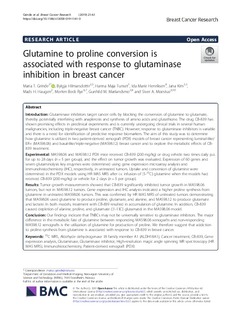| dc.contributor.author | Grinde, Maria Tunset | |
| dc.contributor.author | Hilmarsdòttir, Bylgja | |
| dc.contributor.author | Tunset, Hanna Maja | |
| dc.contributor.author | Henriksen, Ida Marie | |
| dc.contributor.author | Kim, Jana | |
| dc.contributor.author | Haugen, Mads Haugland | |
| dc.contributor.author | Rye, Morten Beck | |
| dc.contributor.author | Mælandsmo, Gunhild Mari | |
| dc.contributor.author | Moestue, Siver Andreas | |
| dc.date.accessioned | 2019-08-08T08:37:00Z | |
| dc.date.available | 2019-08-08T08:37:00Z | |
| dc.date.created | 2019-04-23T10:01:02Z | |
| dc.date.issued | 2019 | |
| dc.identifier.citation | Breast Cancer Research. 2019, 21 (1), 1-13. | nb_NO |
| dc.identifier.issn | 1465-542X | |
| dc.identifier.uri | http://hdl.handle.net/11250/2607522 | |
| dc.description.abstract | Introduction
Glutaminase inhibitors target cancer cells by blocking the conversion of glutamine to glutamate, thereby potentially interfering with anaplerosis and synthesis of amino acids and glutathione. The drug CB-839 has shown promising effects in preclinical experiments and is currently undergoing clinical trials in several human malignancies, including triple-negative breast cancer (TNBC). However, response to glutaminase inhibitors is variable and there is a need for identification of predictive response biomarkers. The aim of this study was to determine how glutamine is utilized in two patient-derived xenograft (PDX) models of breast cancer representing luminal-like/ER+ (MAS98.06) and basal-like/triple-negative (MAS98.12) breast cancer and to explore the metabolic effects of CB-839 treatment.
Experimental
MAS98.06 and MAS98.12 PDX mice received CB-839 (200 mg/kg) or drug vehicle two times daily p.o. for up to 28 days (n = 5 per group), and the effect on tumor growth was evaluated. Expression of 60 genes and seven glutaminolysis key enzymes were determined using gene expression microarray analysis and immunohistochemistry (IHC), respectively, in untreated tumors. Uptake and conversion of glutamine were determined in the PDX models using HR MAS MRS after i.v. infusion of [5-13C] glutamine when the models had received CB-839 (200 mg/kg) or vehicle for 2 days (n = 5 per group).
Results
Tumor growth measurements showed that CB-839 significantly inhibited tumor growth in MAS98.06 tumors, but not in MAS98.12 tumors. Gene expression and IHC analysis indicated a higher proline synthesis from glutamine in untreated MAS98.06 tumors. This was confirmed by HR MAS MRS of untreated tumors demonstrating that MAS98.06 used glutamine to produce proline, glutamate, and alanine, and MAS98.12 to produce glutamate and lactate. In both models, treatment with CB-839 resulted in accumulation of glutamine. In addition, CB-839 caused depletion of alanine, proline, and glutamate ([1-13C] glutamate) in the MAS98.06 model.
Conclusion
Our findings indicate that TNBCs may not be universally sensitive to glutaminase inhibitors. The major difference in the metabolic fate of glutamine between responding MAS98.06 xenografts and non-responding MAS98.12 xenografts is the utilization of glutamine for production of proline. We therefore suggest that addiction to proline synthesis from glutamine is associated with response to CB-839 in breast cancer. | nb_NO |
| dc.language.iso | eng | nb_NO |
| dc.publisher | BMC (part of Springer Nature) | nb_NO |
| dc.rights | Navngivelse 4.0 Internasjonal | * |
| dc.rights.uri | http://creativecommons.org/licenses/by/4.0/deed.no | * |
| dc.title | Glutamine to proline conversion is associated with response to glutaminase inhibition in breast cancer | nb_NO |
| dc.type | Journal article | nb_NO |
| dc.type | Peer reviewed | nb_NO |
| dc.description.version | publishedVersion | nb_NO |
| dc.source.pagenumber | 1-13 | nb_NO |
| dc.source.volume | 21 | nb_NO |
| dc.source.journal | Breast Cancer Research | nb_NO |
| dc.source.issue | 1 | nb_NO |
| dc.identifier.doi | 10.1186/s13058-019-1141-0 | |
| dc.identifier.cristin | 1693367 | |
| dc.relation.project | Kreftforeningen: 90393200 | nb_NO |
| dc.relation.project | Norges forskningsråd: 239940 | nb_NO |
| dc.description.localcode | © The Author(s). 2019 Open Access This article is distributed under the terms of the Creative Commons Attribution 4.0 International License (http://creativecommons.org/licenses/by/4.0/) | nb_NO |
| cristin.unitcode | 194,65,25,0 | |
| cristin.unitcode | 194,65,0,0 | |
| cristin.unitcode | 1920,4,0,0 | |
| cristin.unitcode | 1920,2,0,0 | |
| cristin.unitcode | 194,65,15,0 | |
| cristin.unitname | Institutt for sirkulasjon og bildediagnostikk | |
| cristin.unitname | Fakultet for medisin og helsevitenskap | |
| cristin.unitname | Klinikk for bildediagnostikk | |
| cristin.unitname | Kirurgisk klinikk | |
| cristin.unitname | Institutt for klinisk og molekylær medisin | |
| cristin.ispublished | true | |
| cristin.fulltext | original | |
| cristin.qualitycode | 1 | |

